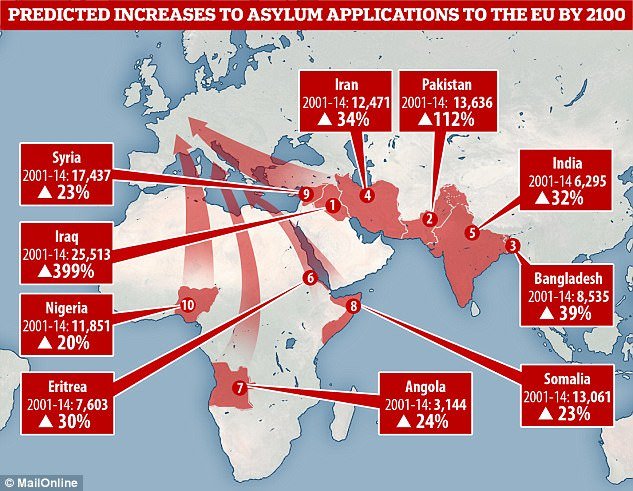
Migrants applying for asylum in the European Union will triple from current levels by the year 2100 due to rising temperatures across the globe, climate scientists claim.
They say Europe could face a ‘massive influx’ of people by the end of the century if carbon emissions hold steady as hotter temperatures will accelerate migration.
A new study suggests that cutting emissions could partially reduce this number, but even an ‘optimistic’ scenario could see asylum applications rise by at least a quarter.
They say that, outside of conflict, temperature changes in agricultural regions during growing seasons are to blame.
The research, led by Columbia University’s school of international and public affairs, suggests that weather shocks in countries around the world have increased applications by asylum seekers hoping to enter the EU.
By the end of the century, even under a slow-warming scenario in which future greenhouse gas emissions decline, applications into the EU could increase by 28 per cent.
And, they could increase by 188 per cent under a fast-warming scenario where future emissions continue to increase.
READ: Nigerian ‘mafia’ working with Libyans to smuggle migrants – Report
Previous studies have found a link between weather variations and migration, but the Columbia team endeavoured to explore this relationship on a greater, global scale.
They analysed EU asylum applications filed from 103 countries between 2000 and 2014, an average of 351,000 applications per year.

They compared this with environmental data across those countries during the same timeframe, and adjusting for other distress factors such as conflict.
They identified a relationship between fluctuations in asylum applications and weather anomalies.
Senior author Professor Wolfram Schlenker, an economist at Columbia, said: ‘Europe is already conflicted about how many refugees to admit.
‘Though poorer countries in hotter regions are most vulnerable to climate change, our findings highlight the extent to which countries are interlinked, and Europe will see increasing numbers of desperate people fleeing their home countries.’
Professor Schlenker and his colleagues found that if temperatures deviated from 20°C (68°F) in each country’s agricultural region during its growing season, the more likely people were to seek refuge abroad.
Crops grow best at an average temperature of 20°C, and so not surprisingly, hotter than normal temperatures increased asylum applications in hotter places, such as Iraq and Pakistan, and lowered them in colder places such as Serbia and Peru.
Combining the asylum application figures with projections of future warming, the researchers found that an increase of average global temperatures of 1.8°C (35°F) – an ‘optimistic scenario’ in which carbon emissions flatten globally in the next few decades and then decline – would translate into 98,000 extra applications to the EU each year.
Read more on MailOnline











